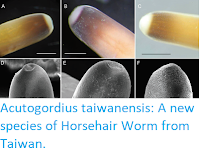Masked Grasshoppers of the genus Poecilocloeus are brightly coloured medium-sized Grasshoppers found in the tropical forests of the Americas, where they are found at all levels within the forest, from low shrubs to the canopy of large trees, though in areas disturbed by Human activity several species formerly found in the canopy have managed to adapt to new environments closer to the ground. To date 64 species have been described, 63 of them from the Amazon Basin and one from Costa Rica.
In a paper published in the journal Insecta Mundi on 27 April 2018, Luis Miguel Constantino of the Disciplina de Entomología at the Centro Nacional de Investigaciones de Café, Oscar Cadena-Castañeda of the Grupo de Investigación en Artrópodos ‘Kumangui’ at the Universidad Distrital Francisco José de Caldas, Juan Manuel Cardona Granda of Carbon Decisions International, and Pablo Benavides Machado and Carmenza Góngora Botero, also of the Disciplina de Entomología at the Centro Nacional de Investigaciones de Café, describe a new species of Poecilocloeus from two Coffee farms in Antioquia Department, Colombia.
The new species is named Poecilocloeus coffeaphilus, meaning ‘Coffee lover’, in reference to its apparent fondness for Coffee Plants. These are medium-sized Grasshoppers, with the males reaching about 22 mm in length, and the slightly more robust females 28-30 mm. They are predominantly dark and lime green in colour, with some pink and yellow markings. The antennae are pink or brown, and the eyes grey. The species is found on the eastern slope of the Western Cordillera of Colombia in the Cauca River canyon at altitudes of between 1600 and 1800 m above sealevel.
The new species is named Poecilocloeus coffeaphilus, meaning ‘Coffee lover’, in reference to its apparent fondness for Coffee Plants. These are medium-sized Grasshoppers, with the males reaching about 22 mm in length, and the slightly more robust females 28-30 mm. They are predominantly dark and lime green in colour, with some pink and yellow markings. The antennae are pink or brown, and the eyes grey. The species is found on the eastern slope of the Western Cordillera of Colombia in the Cauca River canyon at altitudes of between 1600 and 1800 m above sealevel.
Poecilocloeus coffeaphilus (male). (A) Adult male, lateral view. (B) Dorsal view with right wing spread. Constantino et al. (2018).
The species has apparently been known to Coffee farmers in the region since the 1960s, but has not previously been the subject of any published scientific publication. Infestations typically starts on Coffee plots close to remnant fragments of forest and are typically noticed at the beginning of the rainy season (in March) when nymphs begin to emerge from the ground. Since each female is capable of laying 6-8 ootheca (egg masses), each containing 15-30 eggs, the number of Grasshoppers tends to climb rapidly. The nymphs of the species feed on leaves, avoiding the veins, so that the leaves become hollowed out, eventually turning brown and falling. Adults are capable of completely consuming leaves, leaving only the central vein, and will also attack and consume the fruit of the plant (i.e. the Coffee beans). Damage caused by the Grasshoppers can also serve as an entrance for Fungal pathogens, which cause further damage to the plants.
Damage caused by adults of Poecilocloeus coffeaphilus on coffee plants. (A) Close-up of leaf damage. (B) Scrapings on the bark of stems and branches. (C) Damage of ripe fruit. (D)-(E) Damage of unripe and near ripe fruits. (F) Fruits with the pulp consumed. (G) Coffee fruits with the exocarp and pulp completely eaten off and the grains exposed. Constantino et al. (2018).
Away from the Coffee farms Poecilocloeus coffeaphilus was also found in the canopy of the tree Ladenbergia oblongifolia, like the Coffee plant a member of the Rubiaceae, a group of Plants not usually attacked by Grasshoppers, which suggests that this species might have been suitably pre-adapted for the arrival of Coffee, and East Africa plant grown in large monocultural plantations, which clearly provides an excellent new opportunity. As such the species is a serious economic threat, though as Coffee is a rainforest plant growing in ecologically sensitive environments, Constantino et al. caution against trying to control the Grasshoppers with chemical pesticides, instead suggesting that the Grasshoppers could be managed using a biological control such as Nematodes or Fungi.
See also...
Natural enemies of Poecilocloeus coffeaphilus. (A) Leaf Mantis Acanthops centralis. (B) Leaf Mantis
Acontista cordillerae. (C) Nematode Mermis sp., parasite of Poecilocloeus coffeaphilus adults. (D) Assassin Bug Zelus vespiformis.
(E) Entomopathogenic Fungi Beauveria bassiana on adult of Poecilocloeus coffeaphilus. (F) Beauveria bassiana on Poecilocloeus coffeaphilus nymph. Constantino et al. (2018).
See also...
Follow Sciency Thoughts on
Facebook.









